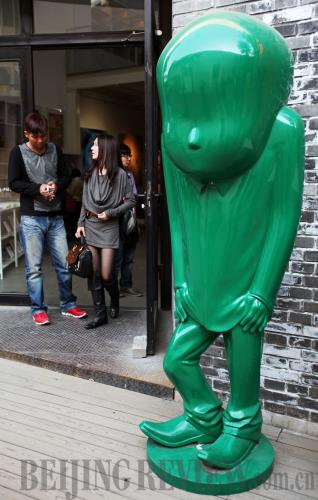|
 |
|
ORIGINALITY: A sculptured creation is displayed at the 798 Art Zone during its fifth festival on October 6 (CFP) |
Abstract contemporary sculptures stand beside big rusty machinery; fashion shows and art exhibitions are given in spacious workshops. Later operation has turned a former quiet place for art creation into a high-traffic art hub for not only artists but also art merchants, visitors and tourists.
"The art creation boom in the 798 area before 2006 was just a kind of spontaneous cultural phenomenon," said Liu Gang, Vice General Manager of Beijing 798 Creative Industry Investment Co. Ltd. Beijing Seven Star established its investment arm in 2007 to build the zone into an exhibition and trade platform for art works.
In 2006, the zone operator set up a management office and lifted the threshold for tenants. Since then a number of heavyweight art institutions such as Pace Beijing, the Iberia Center for Contemporary Art, Galleria Continua and the Ullens Center for Contemporary Art have moved into the zone.
"The 798 Art Zone is now primarily a place where artists hold exhibitions, giving more than 2,000 exhibitions, performances and other art and cultural activities every year," said Zhang Guohua, head of the 798 Art Zone Development and Administration Office.
The new orientation has also caused much controversy. With increases in rents and tourist numbers, some artists have moved out of the art zone because they thought it was no longer suitable for their creation.
"Artists who closed their studios here still give exhibitions, hang out and talk over a couple of coffee with friends in 798, " said Bernell. "They always draw inspiration for creation from the gatherings they have here."
He compared 798 with other art districts developed from deserted factories worldwide. "While many art zones eventually developed into commercial areas, the 798 found itself a different way," he said.
Even those who moved out can still settle down in artistic areas nearby, such as Caochangdi and Huantie neighborhoods which, together with the 798, will form an art cluster, Liu said.
"In fact, the transformation of 798 is benefiting these art districts too, by providing artists opportunities to enter world eminent galleries, of which there are many in the 798 now," he said.
As a frontier of contemporary art in China, 798 is of experimental significance. That is why "the zone operator should pay more attention to the protection and fostering of domestic art institutions and Chinese contemporary art, and at the same time be more open and inclusive to artists," said Li Xiangqun, professor of Tsinghua Academy of Arts and Design, who has a studio in the zone.
By the end of 2010, about 455 studios, galleries, shops and restaurants had been established in the area, increasing from several dozens in early 2002. "The art zone also attracted more than 50 overseas art agencies," said Liu. | 